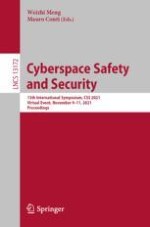2022 | Book
Cyberspace Safety and Security
13th International Symposium, CSS 2021, Virtual Event, November 9–11, 2021, Proceedings
Editors: Dr. Weizhi Meng, Prof. Mauro Conti
Publisher: Springer International Publishing
Book Series : Lecture Notes in Computer Science
